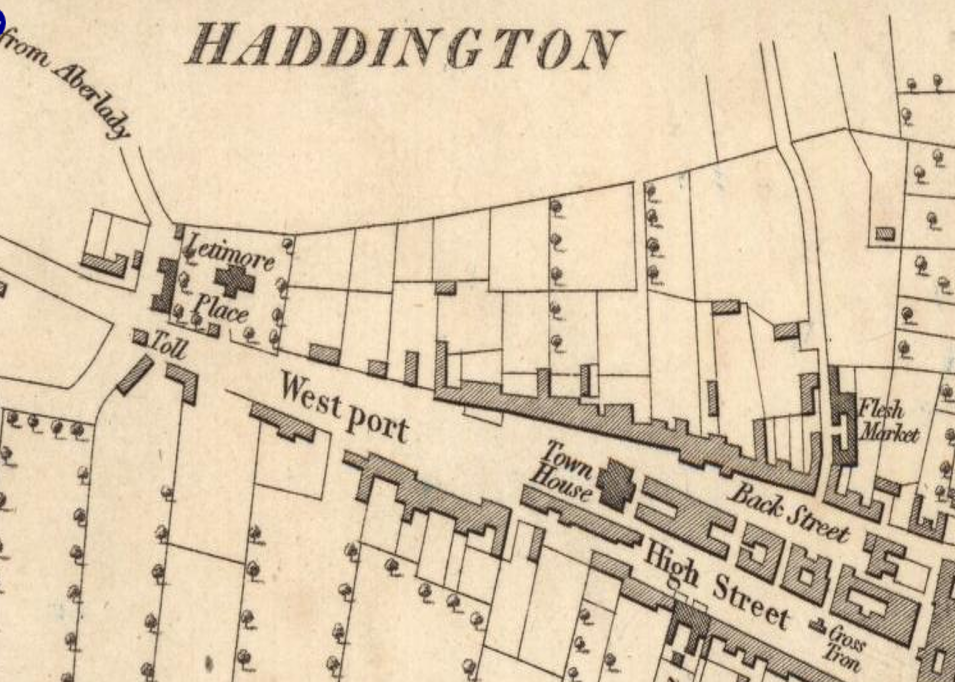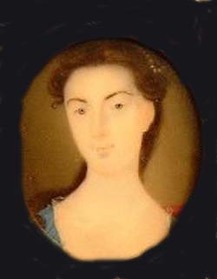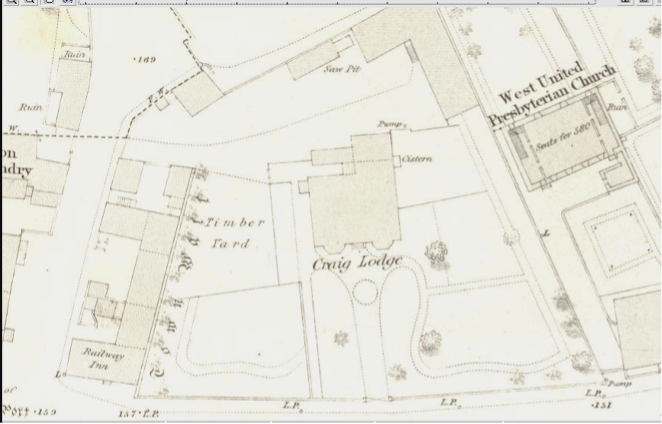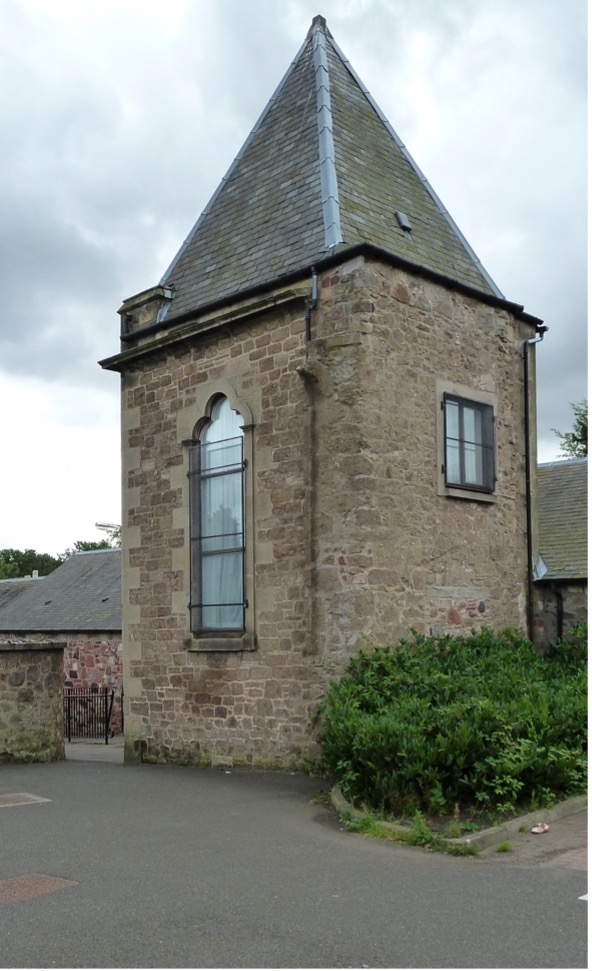A mansion which ruined its builder, cavalry stables and barracks, and secessionist churches once formed part of Haddington’s West Port. The mansion survives, much altered and with two changes of name. A pub stands on the barracks site. The church has moved further west.
Dashed hopes
In 1770 Andrew Leslie, uncle of the 11th Earl of Rothes, borrowed £300 from the Marquess of Tweeddale, a relative, and bought ground in Haddington for £120 from James Dudgeon. It was bounded on the north and west by the Town Wall, on the south by the High Street (now Court Street) and on the east by the house and yard of William Grieve, flesher. Here he built a large house with landscaped grounds. He sold his George Square home and moved in. He called his new house Latimer Place.

(From Andrew & Mostyn Armstrong, Haddingtonshire, 1773, NLS, copied by Thomson 1822 but not updated.)
The ‘cruel and ungenerous’ niece

On the death of her brother, the 11th Earl of Rothes, in 1773, she successfully claimed the Rothes title and estates and became, at the age of 23, the 12th Countess.
This ruined her uncle.
Andrew Leslie had expectations of inheriting the Rothes title and estate and seems to have borrowed heavily on that hope to fund his building plans and to buy further property in Haddington. His grand designs were thwarted by his niece. His claim was rejected by the Court of Session and hers upheld. He was forced to put his newly completed Haddington house up for sale in 1775 to pay his debts. On the day of the sale in December, no bids were received.

“My house, wings, colonade, dairy and other offices, stable, coach and poultry house, walls, gates and pillars, well, pump, leaden cistern and pipe, drain in my garden and field, paling and sunk fence, gravel walks, trees and shrubs with many other articles in and about my house cost me very near £1700″.
Andrew Leslie, 1775
The map shows Craig Lodge (a.k.a. Latimer Place and Hilton Lodge) after much of the land had been sold off but the original extent of Latimer Place and some of the features on which Andrew Leslie spent ‘near £1700’ can still be seen.
The gateway to Hilton Lodge today marks the mid-point of the Latimer Place frontage. It originally extended west to the Town Wall at the point the Railway Hotel (Now The Green) and West Church meet. The end of the Town Wall can be seen in the facade of the Railway.
Latimer Place was eventually sold in 1778 to Major Basil Alves, Fort Major of Edinburgh Castle. In 1789[?] he sold to Mrs Margaret Johnston and her daughter and son-in-law. Mrs Johnston was the widow of Wynn Johnston of Hilton; hence the name Hilton Lodge. Her son, Robert Johnston, inherited. In 1815 the property was sold on to the Dudgeons of East Craig farm who renamed it Craig Lodge.
Dragoons

The site to the west of Latimer Place, between the Town Wall and the Aberlady Road, in 1770 included a corn barn, stables and barnyard. The Green has a similar footprint today. Three hundred cavalry were stationed in Haddington during the Napoleonic Wars when these buildings were converted to stables and barracks for dragoons.
The burgesses had the right to the manure from the stables at 6d per cart or £5 for a year’s output per horse. The site was later acquired by Mrs Johnston of Hilton Lodge.

Mrs Johnston sold her properties west of the Town Wall by auction in 4 lots in 1805 specifying there would be no brewhouses erected and no windows on the east wall of any buildings so that her Hilton Lodge garden was not overlooked.
Dissenters

“violent attempts on the chastity of young women”.
The site just to the east of Latimer Place, once the house and yard of the butcher William Grieve, became home for a century to dissenters. In 1790 some of the congregation of St Mary’s fell out with the new minister and moved here with their own preacher, a Mr Gellatley. He was deposed in 1793 for offences including ‘cursing’, ‘fraud’, ‘lying’, ‘slander’, ‘perfidy’ and “violent attempts on the chastity of young women”. A later minister resigned in 1800 and the congregation dwindled away. The site was used by the Antiburgher Meeting House, then the West U.P. Church. Part of this building remains. The congregation later moved to the West Church, built on what was once part of Latimer Place grounds in 1890.
(C) E.H.Glendinning
Sources
Haddington Burgh Register Sasines NAS B30/2/7-9, B30/3/1-2
Hardy, D. (?2003), Hilton Lodge, the story of a house in Haddington. [This text claims the Johnstons built the house; an error due to a misreading of a sasine.]
Mackenzie, E. (1827) A descriptive and historical account of the town and county of Newcastle upon Tyne, Vol 1, p392 (Newcastle: Mackenzie and Dent)
Yester papers, NLS, Ms14436, ff243-255
(Note index B30/6/1)
You must be logged in to post a comment.